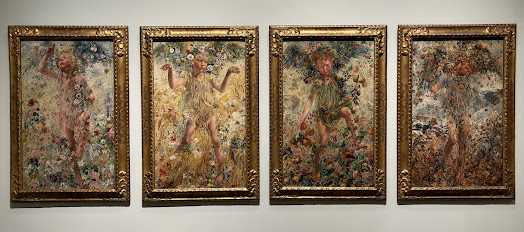A very impromptu visit was to the Philadelphia Museum of Art. We decided to drive into the city and see if/where we might find a parking space and there, across the street, was the perfect spot. This was a first visit for us.
The museum was originally chartered in 1876 for the Centennial Exposition in Philadelphia and administers collections containing over 240,000 objects including major holdings of European, American, and Asian origin.
If you've seen the movie Rocky, you surely remember Rocky running the 72 stone steps as he trained for a fight with Apollo Creed, the World Heavyweight Champion. The scene is widely considered one of the most iconic in the history of modern films. Tourists often mimic Rocky's famous climb, which has become a metaphor for an underdog rising to a great challenge. Today was no exception.
Waiting to make the climb - phones ready!
Before we started our climb, we stopped at the bronze Rocky statue at the bottom of the steps.
And then it was time to climb.
Halfway point
We are not really art "fans" but it was nice to see some of the pieces we've either seen in photos or read about.
Sunflowers 1889, Vincent van Gogh, Dutch, 1853-1890, Oil on canvas
When Paul Gauguin visited Van Gogh in Aries in September 1888, he discovered two paintings of sunflowers - one with a yellow background and the other a turquoise background - decorating his bedroom. Van Gogh was fond of the humble, cheerful flower and created these ambitious compositions to welcome his friend.
Following Gauguin's departure, Van Gogh returned to the sunflower motif, painting this version from memory in January 1889, giving each bloom its own personality and richly worked texture, causing Camille Pissaro to marvel: "Vincent's flowers look like people!"
The Four Seasons, 1893 (Spring), 1894 (Summer, Fall, Winter), oil on canvas
Leon Frederic, Belgian, 1856-1940
With obsessive attention to detail, Frederic envisions the seasons as four prancing children. Enveloped by flowers and fruits, they absorb the earth's energy (spring), sow seeds (summer), gather a harvest (fall), and fall asleep (winter).
Shot Orange Marilyn, 1964
Andy Warhol, American, 1928-1987, Acrylic and screen print ink on linen
Renoir worked longer and harder on this lighthearted bathing scene than on any other painting in his career. Over three years, he made numerous studies for the figures in an effort to resolve their poses, settle the complex web of limbs in the center of the picture, and refine his approach to line and contour. Expressing satisfaction with the final composition, he dubbed it his "masterwork."
The Great Bathers, 1884-1887
Pierre-Auguste Renoir, French, 1841-1919
Oil on canvas
An air of mystery pervades this wintry forest landscape. Dressed in festive carnival costumes, a couple stands in front of barren trees, their figures seeming to shine from within rather than from the light of the moon, which has left the forest in darkness. An unexplained face peers out from the empty hut beside the figures, and an unexpected streetlamp glows strangely nearby.
Known for his fantastic scenes, Rousseau was a self-taught artist whose works appealed to adventurous collectors and artists like Pablo Picasso.
Carnival Evening, 1886
Henri Rousseau, French 1844-1910
Oil on canvas
The Cubist concert has been discussed as a symbolic remembrance of lost prewar friendships among Picasso (as the trickster figure Harlequin playing a violin on the left), the deceased poet and critic Guillaume Apolinaire (as Pierrot, depicted in the center with a recorder or clarinet), and the poet Max Jacob (as a Franciscan friar holding an accordion at the right), who by this time had become estranged from the artist's circle.
It is probably also an acknowledgement of three composers with whom Picasso had recently collaborated on the productions of the renowned, innovative Ballets Russes dance company. No single interpretation suffices.
Three Musicians, 1921
Pablo Picasso, Spanish 1881-1973
Oil on canvas
The museum also houses the armor collection of Carl Otto Kretzschmar von Kienbusch. This collection was bequeathed by the celebrated collector to the museum in 1976, the Bicentennial Anniversary of the American Revolution. The holdings are comprehensive and include European and Southwest Asian arms and armor spanning several centuries.
The four medieval European swords in the front row of this case are exceptional, both for their superior state of preservation and for the fact that they can be dated fairly precisely. Unlike most surviving medieval swords, these were not excavated, but rather come from armories in which they had remained for centuries. The Arabic inscriptions on their blades record that they entered the arsenal of the Mamluk sultans of Egypt and Syria in Alexandria in the fourteenth and fifteenth centuries.
These crossbows were made in Austria c. 1470-1500. They are made from wood, horn, birch bark, paper, flax, cord, leather and steel.
This hall was covered with tapestries.
This tapestry shows the Sea Battle between the Fleets of Constantine and Licinius. It was designed in 1632-1636 and made in 1633-1637. Central scene designed by Pietro da Cortona, 1596-1669.
What is happening in this tapestry? Emperor Constantine's navy, marked by crosses on the top of his military standards, advances from the left. The fleet of Emperor Licinius, bearing eagle-topped standards, is losing smoke bellows over its vessels and in the right foreground one of its ships begins to sink.
There was so much to see but one more thing caught our eye as we left the museum.
This bronze monument portrays the nation's first president, George Washington, in his role as commander in chief during the Revolutionary War (1775-1783). The allegorical figures on the pedestal represent Washington's era in American history. The groups arranged around the lower level show Native American people as well as animals and plants of the period.
The monument was donated to the City of Philadelphia by the State Society of the Cincinnati of Pennsylvania, a group of descendants of Revolutionary War officers.
Washington Monument, 1897
Rudolf Siemering, 1835-1905
More on our visit to the city in my next post.

















































